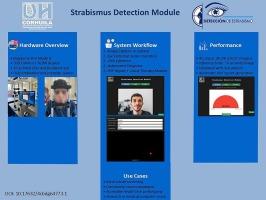一种用于视觉失调筛查的嵌入式诊断工具的开发
IF 2.1
Q3 ENGINEERING, ELECTRICAL & ELECTRONIC
引用次数: 0
摘要
本文介绍了一种基于计算机视觉和深度学习的低成本嵌入式斜视初步筛查系统的设计、实现和验证。硬件集成了树莓派4,USB摄像头和3d打印的下巴托,以确保面部定位一致。该软件使用Python开发,使用PyQt5和OpenCV,将NASNetLarge卷积神经网络转换为TensorFlow Lite用于实时推理。图形界面允许用户捕获或上传图像,执行自动分析,生成诊断PDF报告,并访问游戏化治疗模块。功能验证包括27张图像的专有数据集,分类准确率达到96.30%。此外,对1000张图像的平衡数据集进行分层10倍交叉验证,平均准确率为95.6%,具有很强的泛化指标(f1得分、精度和召回率高于94%)。通过逐帧分析瞳孔到刺激点的距离,实现了一种新的治疗验证机制,确认了可靠的眼动追踪和系统检测微斜视的潜力。这种开放源代码的便携式原型适用于社区健康检查和教育用途,特别是在资源匮乏的环境中。本文章由计算机程序翻译,如有差异,请以英文原文为准。

Development of an embedded diagnostic tool for visual misalignment screening
This article presents the design, implementation, and validation of a low-cost embedded system for preliminary strabismus screening, based on computer vision and deep learning. The hardware integrates a Raspberry Pi 4, a USB camera, and a 3D-printed chin rest to ensure consistent facial positioning. The software, developed in Python using PyQt5 and OpenCV, incorporates a NASNetLarge convolutional neural network converted to TensorFlow Lite for real-time inference. The graphical interface allows users to capture or upload images, perform automated analysis, generate diagnostic PDF reports, and access a gamified treatment module. Functional validation included a proprietary dataset of 27 images, achieving a 96.30 % classification accuracy. Additionally, a stratified 10-fold cross-validation on a balanced dataset of 1000 images yielded an average accuracy of 95.6 % with strong generalization metrics (F1-score, precision, and recall above 94 %). A novel treatment validation mechanism was implemented by analyzing pupil-to-stimulus distance frame-by-frame, confirming reliable eye tracking and the system’s potential for detecting microstrabismus. This open-source, portable prototype is suitable for community health screening and educational use, particularly in low-resource settings.
求助全文
通过发布文献求助,成功后即可免费获取论文全文。
去求助
来源期刊

HardwareX
Engineering-Industrial and Manufacturing Engineering
CiteScore
4.10
自引率
18.20%
发文量
124
审稿时长
24 weeks
期刊介绍:
HardwareX is an open access journal established to promote free and open source designing, building and customizing of scientific infrastructure (hardware). HardwareX aims to recognize researchers for the time and effort in developing scientific infrastructure while providing end-users with sufficient information to replicate and validate the advances presented. HardwareX is open to input from all scientific, technological and medical disciplines. Scientific infrastructure will be interpreted in the broadest sense. Including hardware modifications to existing infrastructure, sensors and tools that perform measurements and other functions outside of the traditional lab setting (such as wearables, air/water quality sensors, and low cost alternatives to existing tools), and the creation of wholly new tools for either standard or novel laboratory tasks. Authors are encouraged to submit hardware developments that address all aspects of science, not only the final measurement, for example, enhancements in sample preparation and handling, user safety, and quality control. The use of distributed digital manufacturing strategies (e.g. 3-D printing) is encouraged. All designs must be submitted under an open hardware license.
 求助内容:
求助内容: 应助结果提醒方式:
应助结果提醒方式:


